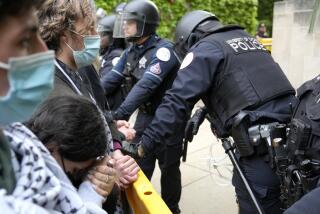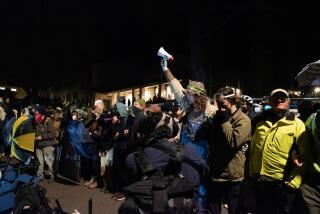College Rethinks Its Commitment to Serving Poor
- Share via
PHILADELPHIA — In 1884, when a Baptist minister named Russell H. Conwell founded Temple University amid the gritty factories of North Philadelphia, he looked upon the poor, untutored children of its black and immigrant workers as “acres of diamonds,” rough gems needing only education to become valuable citizens.
Ever since, though it lacked the prestige and financial resources of more favored schools, “Temple has always been about that, a poor school for poor students,” Robert S. Schneider, a university administrator, says with deep-felt satisfaction.
Given that dedication to diversity, Temple might have hoped for relatively smooth sailing last week when it joined colleges from coast to coast in taking up President Clinton’s national dialogue on race.
Instead, during four days of campus forums, the school found itself the target of protesters hurling such terms as “racist’ and “apartheid.”
The forums designed to bring diverse groups closer together became a graphic illustration of just how deep the chasm of race remains, even at a school where 40% of the students are minorities.
More specifically, the debate at Temple illuminated one of the deepening questions in America’s racial evolution: Can an institution simultaneously undertake twin tasks of seeking excellence and boot-strapping those left behind without pulling itself apart? Temple is embarked on just such a journey, and the answer last week was far from clear.
The White House call for colleges and universities to devote a week to the initiative on race came at a time when the Temple community--students, faculty, administrators and leaders from the surrounding area--were locked in controversy over a highly concrete
blueprint for change that the university had recently adopted.
Never mind that Temple’s record of service to students who lacked the advantages of Ivy League lineage is as old as the school itself. Never mind that university officials insist the plan, known as the Strategic Initiative, is necessary to assure Temple’s survival as a first-class university. Never mind that the initiative is little different from strategies being adopted by schools across the country as competition in higher education grows fiercer.
Nothing, the discussions here made clear, would be taken on faith. Old wounds, continuing grievances, conflicting agendas, mistrust and skepticism that had been ingrained in many from childhood--all these and more boiled to the surface, barriers to understanding.
“We should have known better,” university Provost Corrinne Caldwell says ruefully. “We assumed that people knew our record, and we were surprised when that did not carry us through.”
Among the school’s almost 30,000 students, 58% are white, 22% are African American, 11% are Asian and 3% are Latino. The remainder includes Native Americans and students from other countries. So diverse is the population at Temple’s main campus that some white freshmen say that when they first arrived, they thought they had inadvertently chosen a predominantly black college.
Against such a background, says Marcie Mackin, assistant to the director of enrollment services, “this university has a really terrific record on diversity, yet every single thing it does is examined under the microscope of racism.”
Plan Addresses Declining Fortunes
The decision to make changes at Temple, a part of Pennsylvania’s state-supported system of higher education, was a response to years of declining fortunes.
Like many other universities serving urban populations, Temple has struggled with declining numbers of applicants, lower academic quality among students from city high schools, increasing difficulty seeing such students through to graduation (attrition rates from freshman year to graduation had reached 40%) and an ominous tendency for good students in the region to look elsewhere.
The driving source behind those trends is plain to see all along North Broad Street, the wide, once-handsome avenue that runs in front of the main campus that used to serve the working-class heart of a great industrial city, home to Nabisco, for example, and the Flexible Flyer sled.
Today, most of the factories are gone, along with the jobs and more than half a million people who have left Philadelphia since 1950.
Left behind is the familiar landscape of urban poverty.
“The whole area has just changed,” laments Bernadette Norton, who grew up in North Philadelphia and now works at Temple. “There is not that backbone of working-class families.”
Academically, inner-city blight translates into high schools that turn out graduates staggeringly unprepared to meet even the most rudimentary college standards.
For example, consider a case that was on the tips of Temple administrators’ tongues last week. One member of next fall’s freshman class was valedictorian at a large Philadelphia high school, had a near-perfect grade-point average and excelled in extracurricular activities.
A seemingly ideal candidate, except that--after two practice runs--the student’s combined scores on the Scholastic Aptitude Tests for math and verbal skills added up to less than 600, on a scale of 400 to 1,600. That is just over half the average combined score, 1,012, for Temple’s Class of 1997.
In this instance, says university provost Caldwell, “I suspect the student will do all right. That record must have been accomplished through hard work, and hard work will carry you a long way.”
But prospects have not been so good for most of those admitted from such backgrounds. Nine out of 10 of these so-called developmental students fail to survive.
Jovan Jakovac, a 31-year-old Serbian doing graduate work in economics, puts his finger on what that can mean in the classroom. “I speak better English than most of the students in my classes,” he declared one afternoon last week. “How can that be?”
Weak preparation and high attrition rates are not only costly for the university, but they are also economically and emotionally damaging to the individuals. “What all these students ended up with was debt and negative feelings about education,” Caldwell says.
“If we can’t give students a quality education here, we shouldn’t take them,” she says, noting that Temple is working more closely with area community colleges, which can help these disadvantaged students at far less cost.
To address these and related problems, the Strategic Initiative was developed by university President Peter J. Liacouras, the son of a Greek immigrant who started life homeless. The plan calls for raising admission standards, accepting fewer freshmen with below-par skills, trimming remedial programs for those who could not do college work and refocusing such efforts on those more likely to succeed.
Also, Temple has stepped up recruitment in the suburbs. After all, says Thomas F. Maxey, director of enrollment services, the half-million people who have left the city in recent decades “didn’t move to Los Angeles or Florida or Belgium. They moved to the suburban counties of Pennsylvania and New Jersey.”
“Better students breed more better students,” says Maxey, noting that applications are already nosing upward.
Does all this mean Temple is turning its back on those it traditionally served? Is it trying to become more “white?” More “male?” More “suburban?”
Not really, officials insist, noting that minority enrollments are still rising--with the numbers of Asians and Latinos growing fastest. And Temple must grow stronger, not weaker, officials argue, if it is to continue serving its neighbors as well as the larger region, whose residents, after all, are taxpayers too.
“We’re talking about gradations,” not drastic change, Schneider says.
Deep Anxieties and Concerns
Reasonable, even unavoidable as Temple’s “repositioning” might be, it has stirred deep anxiety and concern almost everywhere.
Some opposition reflects conflicting agendas. Tyrone Reed, a community leader participating in one of the forums, is among those who feel Temple should put service to the most disadvantaged ahead of concern for academic standards.
“In itself it is racist, when you say bringing in people from the urban area reduces the quality of education,” he says. “. . . Don’t say you have to go to the suburbs. They are better prepared, but that doesn’t necessarily mean their contribution here will be greater.”
Darryl Powlus, a white, 25-year-old senior who chose Temple because of its diversity, supports the effort to raise standards. “It cheapens the whole university” when unprepared students are admitted, he said during a break between classes.
But he and other students think the school needs to do a better job helping diverse students come together. Temple’s required classes on racism, he says, often “boil down to arguments between blacks and whites. . . . They bring out hate inside you that you didn’t want to feel.”
Powlus’ view was only one of many reminders that what stands in the way of understanding and accommodation is more than ancient history. Indeed, perhaps the most striking feature of Temple’s week of dialogue may have been the way it revealed how fresh and painful the experience of race remains.
For example, in a small discussion group led by U.S. Atty. Gen. Janet Reno, who came here as part of the dialogue program, a young Temple student named Elicia Kim, whose parents are Korean and German, said she often endured racial slurs in the Pennsylvania town where she grew up.
“It just goes on and on, from generation to generation,” said Gianna DeSimone, whose parents are Italian and Filipino.
And Edwin Beausoleil, the cosmopolitan student government president who grew up in Ghana and Europe, reminded participants that the problem is in some ways uniquely American.
“When I was going to school in Switzerland, I was Edwin. Not until I came to the United States did Edwin become ‘the black guy,’ ” he said. “To cure this disease of racism, we must first see ourselves as members of the human race.”
No easy task. Whether the issue is something as far-reaching as the Strategic Initiative or some less cosmic issue, at Temple the shadow of race is inescapable.
Not long ago, the school radio station, WRTI, acquired a huge collection of classical music CDs. It changed its all-jazz format to half jazz, half classical. The audience tripled, as did financial contributions.
But some accused the station of abandoning African American culture and succumbing to racism.
“This is a place,” said university Executive Vice President James S. White, “where the dialogue on race takes place every day of the week.”






